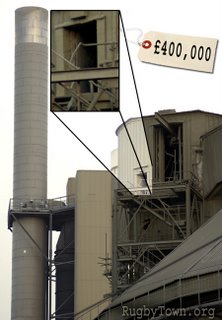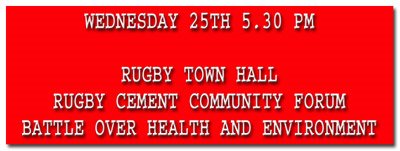 (Click pic to enlarge)
(Click pic to enlarge)SLOPPY ATTITUDE REVEALED AS CEMEX BRING IT ON THEMSELVES.
CEMEX HAVE AN "OPEN DOOR" POLICY but is this what they mean?
At Warwick Court on 3rd October Judge Recorder Michael Stephens put a £400,000 price tag on Cemex for "having an open door on the Clinker Reject Silo." Prosecuting for the Environment Agency was Barry Berlin who made good his case that Rugby residents should not have been exposed (on 14th October 2005) to tonnes of sticky potentially-toxic hazardous dust that rained down on them, coating cars and houses, up to 4.5 kilometres away during a time of instability at the plant. Despite being told about the door and dust Cemex continued to re-start the kiln after a kiln flush and a fire. Ms Lucy Allen said in their defence that they "had no option" to shut down the kiln and that they "had" to keep the kiln running and to restart it in order to protect the kiln and conveyor from expensive damage from hot materials, and to protect the workers, and to prevent an even worse disaster - more emissions. It was said that the kiln flushes cannot be controlled or predicted and when they happen the molten rock rushes through with a fury, and the REJECTED (only partially processed) clinker is diverted into the Reject Silo, causing excessive dust to build up. Unfortunately, so we are told by an early morning vigilant Lawford dog walker, the dust was not contained and was seen to be coming out of the open door. Goodness knows what GAS, dioxins, VOCs etc also escaped - this aspect was not touched on, nor was the exact nature of the dust, except to say it was "potentially hazardous and toxic", and about seven tonnes - according to the BBC report on Midlands Today.
During this time of plant instability an excess of Reject Clinker was made and this was reported to contain more smaller particles that have the potential to be inhaled and absorbed by the lungs and blood stream. The impact of this on human health was simply not quantifiable, but was regarded as "not insignificant" and as an unacceptable "increased risk" to the public. The arguments ranged about the alkalinity of the dust, chemical burns and damage to nerve endings. It was said to be lucky that it was not raining as the dust is only dangerous when wetted, causing a chemical reaction - as when it gets in people mouths? Unless they have a dry-mouth? Rugby Borough Council's one TEOM monitor at Lawford School was quoted as "not showing an exceedence of the PM10 daily limit", but it was rightly recorded that the "dust plume" may not have gone over that particular monitor, and that no one could say what impact the 7 tonnes of "dust and particulate" had had on the long-suffering residents. Lucy Allen pointed out that " a year on and no one has complained of any health effects from it", so she claimed it was "only a short-lived episode with no apparent health impact". The event had, unfortunately for residents, co-incided with high background levels of particulate in the region. An argument went on about how much Cemex had contributed to these unusually high readings of PM10 particulate, that had apparently come from "other polluting industries in the region".??
The Court heard how Cemex did not have a proper system of checks, or record keeping, and that they failed to check every door on every shift, and that this particular door was only "viewed from the ground" some 150 feet below. They could not see that it was hanging off its broken hinges. The poor plant maintenance was criticised and the Judge also criticised them for not closing the plant when the problems were revealed, and said they were guilty of having a "sloppy attitude" and that this was a "recipe for disaster". Cemex said they did not mend it properly on the first day it was discovered because the "shift had ended", so they apparently just "botched it up", and then repaired it properly the next morning.
Small wonder (ashen and trembling) Cemex managers were too shocked to hardly stand up in the Courts after the sentence was read out, as they could not believe their ears, as normally all these "pollution incidents" go on, to a greater or lesser extent, without ANY penalty. The Agency usually dismisses all our complaints and disregards them. How many times have the people been coated in dust, since this new plant began operating in February 2000 - but oh I nearly forgot, that is "different" that is "permitted dust" from a "permitted stack, or source" and this October 14th incident was "not permitted", well at least not permitted from THAT source anyway!
CONFUSED?
Dust on the brain? Let me explain and help you.. See there is dust, and er, mmm, er, well - dust. Got it?
The Judge had trouble getting his head round it - in common with most people, including the Agency and plant operators. When is dust "permitted dust" from a "permitted source" and when is it "not permitted dust" or a "dust from a not permitted source"? What difference do the Rugby people notice about the dusts? Do they feel better to know they are being coated in "permitted dust"? Is some dust positively "good for us" and a daily dose recommended, or is all dust bad for us? Or is some dust worse than others, whether permitted or not permitted? I hope that is clear to you now, clear as dust. Oh and I did not mention particle size as you may become rather confused - leave that till another day shall we?
WHAT IMPACT DID THE TYRE BURNING TRIAL HAVE ON ALL THIS?
The Tyre Trials had started on 11th October 2005 after the baseline test with "coal only" had been completed. We have no evidence to say whether tyres were in the system at the time of the event on 14/15 the October - we have no data at all about this period, no data about the tyre trials until 21st October. In the Court we heard the main stack particulate emissions were running for some unspecified time at 630 mg/m3 instead of the maximum 55 mg/m3 that is "permitted" by the Agency.
In cement kilns any changes in raw materials and fuels have to be handled very carefully, else the kiln will become "upset" and "unstable". When you are "cooking" daily about 7,000 tonnes of mixed raw materials with about 700 tonnes of fuel to heat it to make 5,000 tonnes of clinker then it is easy to see how things might and do EASILY and FREQUENTLY go wrong.
The Agency usually has its hands tied behind its back as they have "permitted" this plant to "pollute Rugby people to a certain (agreed by the EA and Rugby Cement) extent". RBC also claim that they have been involved all along and that they have AGREED the "quantity and type of pollution" to be put on Rugby people. This was NEVER agreed with Rugby residents as we simply were NOT CONSULTED and were NOT INFORMED. This information was NEVER revealed to residents and indeed Rugby Borough Council and the Agency went out of their way to act in SECRECY and TO KEEP IT OFF THE PUBLIC REGISTER and keep it OUT OF THE PUBLIC DOMAIN. The reports and IPC applications were headed "do not divulge to anyone outside of your organisation." The IPC application in June 1999 was COMPLETELY hidden from Rugby people, and the subsequent IPPC application (2001) was only "partially revealed" with the MOST damaging pollutants being hidden by RBC, the EA, and Rugby Cement.
SLOWLY SLOWLY THE TRUTH IS BEING REVEALED.... despite the attempts by all the authorities involved, including Warwickshire County Council, to hide the FACTS about how this plant came to be UNLAWFULLY built and UNLAWFULLY operated in Rugby. As everyone now AT LAST apparently accepts, and knows, no one can possibly cart 3 million tonnes of dusty raw material and various dusty industrial wastes into a town by lorry and pipeline, and then dry it out, and cook it up in a monstrous frequently-unstable plant, heated by about 300,000 tonnes of "various fuels and wastes" in order to make 2 million tonnes of a different DUST (cement) without dumping a WHOLE LOT of DUST and other pollutants onto local people.
Small wonder Cemex and DAVID EVANS, long-term employee of RUGBY CEMENT, are shocked by the size of the fine, as they know too well that "cement plants are always dusty", and Cemex "bought the plant in good faith", and naturally they expect to dump dust all over us. They turned off the 3,000 alarms - to help it run better - according to a Financial Times report last year.
IN COMMON WITH EVERYONE ELSE IN THE WORLD CEMEX will rightly be wondering WHY the b. hell the Environment Agency and Rugby Borough Council and Warwickshire County Council actually HELPED Rugby Cement to design and build and operate this polluting plant IN the urban smokeless zone of RUGBY TOWN. They will also wonder why the public complain so much when there is obviously NO DESIGN FOR A NON-DUSTY CEMENT PLANT ANYWHERE IN THE WORLD.
MANY PEOPLE COMPLAIN AND MANY PEOPLE DESPAIR BECAUSE WE HAVE BEEN CHEATED AND LIED TO FOR SO LONG BY ALL THE AUTHORITIES INVOLVED. WE ARE WORRIED ABOUT THE LONG-TERM AND SHORT-TERM HEALTH IMPACTS ON OURSELVES AND OUR CHILDREN. WE ARE SICK OF BEING LIED TO AND BEING GIVEN FALSE AND MISLEADING INFORMATION. AND WE ARE FED UP OF BEING OVERSHADOWED IN EVERY AREA OF THE TOWN BY AN UNLAWFUL MONSTROUS DEPRESSING UGLY INDUSTRIAL BEHEMOTH. WE ARE SICK OF BEING COVERED IN DUST, PLUMES, AND POLLUTION, AND LORRIES, THAT HAVE CERTAIN, BUT UNKNOWN AND UNQUANTIFIABLE, HEALTH EFFECTS, THE SEVERITY OF WHICH CAN ONLY BE GUESSED AT DUE TO THE LACK OF DATA PROVIDED ABOUT THE EMISSIONS AND THE POLLUTANTS.
WE ARE FED UP OF BEING EXPERIMENTED ON, WITH MORE EXPERIMENTS SET TO START IMMINENTLY AS THE AGENCY PERMIT TYRE AND PETCOKE TRIALS, BEFORE THEY THEN START TO EXPERIMENT WITH THE BURNING OF LONDON HOUSEHOLD AND COMMERCIAL WASTE. WE ARE MORE THAN FED UP BY THE WAY THE AUTHORITIES HAVE TREATED US, AND BY THEIR ATTITUDE TO OUR REQUESTS FOR INFORMATION, AND BY THEIR REFUSAL TO ANSWER ANY STRAIGHT FORWARD QUESTIONS.
WE ARE FED UP WITH THIS ATTEMPTED COVER-UP WHICH HAS UNNECESSARILY COST US A VAST AMOUNT OF MONEY. RUGBY PEOPLE HAVE BEEN RIPPED OFF!
I trust I have made my point clear? And not only that but the Tyre Burning Review Group have just issued a damning report which will make everyone EVEN MORE WORRIED!
Watch this space.







